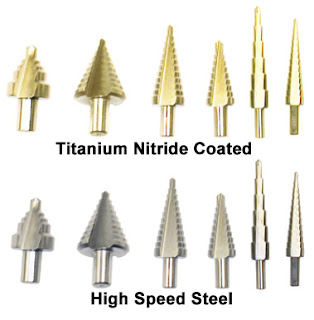Every type of drilling work can be done efficiently using the right tool. Well, picking the best appropriate tool is a daunting task until you are unfamiliar from the characteristic of the drill bits. Plenty of bits are available in machine shops which are intended for various drilling purposes. Some of them are used to bore holes in concrete or brick walls while some are designed for drilling in wooden surfaces, named masonry and auger bits respectively.
Plenty of others are also out there. Let’s have an introductory discussion about the step drill. This bit is used on metal surfaces and you need to apply desired pressure and can start drilling at a slower speed for an accurate hole. Using this bit, you can bore various sizes of holes. However, you cannot bore a deeper hole than the 1/4th of an inch through this thin bit. So, you can only use it on thin metal surfaces, not on hard metals.
Plenty of others are also out there. Let’s have an introductory discussion about the step drill. This bit is used on metal surfaces and you need to apply desired pressure and can start drilling at a slower speed for an accurate hole. Using this bit, you can bore various sizes of holes. However, you cannot bore a deeper hole than the 1/4th of an inch through this thin bit. So, you can only use it on thin metal surfaces, not on hard metals.
This drill rotates clockwise in metal sheets step by step. Each step enlarges the previous hole while the smallest bit doesn’t require any pilot drill to start the drilling process. On the other side, the larger bits always require a pre-drilled hole. There is a central punch to decide at which position, the hole will be. This central punch helps in creating a pilot hole. And, a pilot hole is enough to describe the precision and accuracy in drilling.
Well, you should always drill at a very slow speed with the right amount of pressure and torque. If you keep the speed faster, it will generate great heat on the metal surface which can damage the bit. Keep the speed slow and pressure high to initiate the hole. After drilling the pilot hole, now you can release some pressure for further drilling.
Let’s understand its design which has several steps of different diameter, from the tip to its ground level, each for creating different size of holes. Thus, it is named so and can be used for various purposes and for various applications, especially for countersink and counterbore. So, don’t forget to keep a step bit in your tool box.
Well, you should always drill at a very slow speed with the right amount of pressure and torque. If you keep the speed faster, it will generate great heat on the metal surface which can damage the bit. Keep the speed slow and pressure high to initiate the hole. After drilling the pilot hole, now you can release some pressure for further drilling.
Let’s understand its design which has several steps of different diameter, from the tip to its ground level, each for creating different size of holes. Thus, it is named so and can be used for various purposes and for various applications, especially for countersink and counterbore. So, don’t forget to keep a step bit in your tool box.

No comments:
Post a Comment